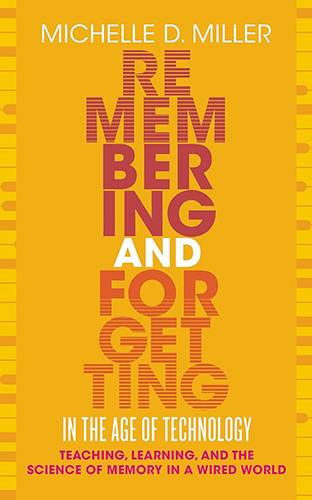


The Spring 2024 Faculty Forward Book Club read Michelle Miller’s, Remembering and Forgetting in the Age of Technology. This book explores the relationship between our ability to remember things and the effect of technology on our memory. In five virtual midday sessions participants discussed such topics as:
As we paced ourselves through the book, the first session explored some common narratives about technology. These include the idea that technology degrades our cognitive abilities. This idea is not supported by research, and in fact, technology helps us make the most of our cognitive abilities (Miller, p. 42). Another common narrative is that smartphones reshape the brain. This is true, but not necessarily in a bad way – and older technologies such as reading itself also reshape the brain (Miller, p. 42). Other points from the book include the idea that offloading cognitive processes to a computer helps us to be more effective, and that our relationship with technology is reciprocal. Miller posits that, as technology changes, so do our methods of working with information both cognitively and procedurally. This does not mean that our cognitive abilities degrade. Instead, they evolve (Miller, p. 43).
In the next session we discussed human memory itself; the things that help us remember, and features contributing to forgetfulness. Things that help us remember include personal relevance, emotional connection, connection to prior knowledge, and the structure and organization of information (Miller, p. 83). When information is disjointed or very similar to other memories, or not relevant to our goals, it will be more easily forgotten (Miller, p.83).
Memory is complex. It moves through our senses into short-term then long-term status. The processes of memory also include encoding, storage, and retrieval (Miller, p.83).
Our conversations moved on to how we can enhance memory and why it’s important. Remembering allows us to apply factual knowledge quickly and effectively in a discipline and to extend our knowledge to new domains (Miller, p. 129). This is the essence of creativity, the highest level of learning. Teaching strategies that accelerate memory include pre-quizzing to bring prior knowledge to the forefront, just-in-time teaching, applied and problem based learning activities, and well-designed multi-media. Retrieval practice and spacing are also good techniques to enhance memory (Miller, p. 130). Technology tools can be valuable aids to implement any of these teaching strategies.
We also explored our devices and their effect on our attention. Being able to focus our attention is essential to memory and learning. A common myth that Miller debunks is that attention spans are shrinking. Research indicates that humans do not have a ten-minute limit on attention. However, digital devices contribute to burnout and fatigue of the brain (Miller, p. 167). We need to be aware of this so we can use and control our
devices in a way that they are not constantly distracting us. We can also use our devices to enhance our memory by setting alarms and reminders for things that are important to us (Miller, p. 168). Education – designed to inform people about the truths associated with attention, memory, and the role of technology – will help people to manage technology for better outcomes (Miller, p. 168).
As educators, it is important for us to understand the relationship between memory, attention, and technology. This five-part Book Club discussion was lively with many participants sharing their personal perspectives and experiences with the information provided in Michelle Miller’s book.